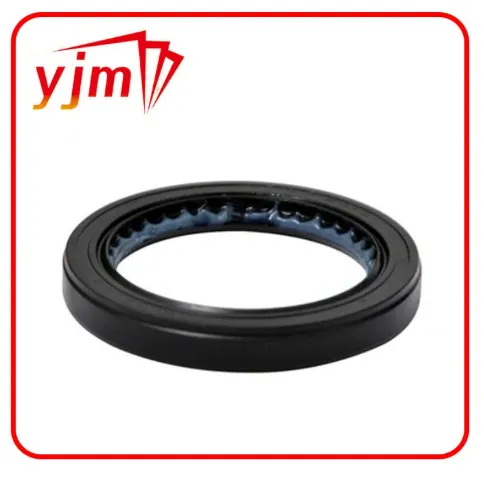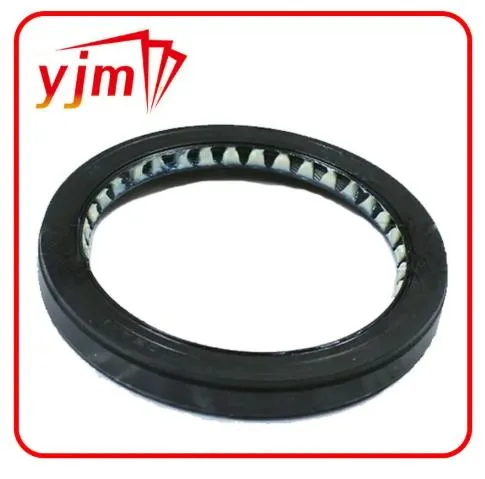The Vital Role of Front and Rear Crankshaft Seals in Engine Protection
In every internal combustion engine, effective sealing is crucial for ensuring performance, reliability, and longevity. Among the most critical sealing components are the front and rear crankshaft seals, which prevent oil leaks and protect internal components from external contaminants. These seals, along with related parts such as the front crank, front crank oil seal, front crank shaft, front crankcase seal, front engine oil seal, front main engine seal, and front main oil seal, all work together to keep the engine clean, lubricated, and running smoothly.

Understanding the Front Crankshaft Area and Its Seals
The front crankshaft area is located at the engine's timing end, where the crankshaft connects to components like the timing gear, serpentine belt, and harmonic balancer. It plays a vital role in engine timing and accessory drive.
Front Crank and Front Crank Shaft
The front crank or front crank shaft refers to the forward portion of the engine's crankshaft, which extends through the front of the engine block. This area is a major exit point where rotational motion is transferred to the vehicle's timing and accessory systems. Because it protrudes from the engine, it must be sealed carefully to prevent oil leaks.
Front Crank Oil Seal and Front Engine Oil Seal
The front crank oil seal—sometimes called the front engine oil seal—is designed to create a tight seal around the crankshaft where it exits the engine. This seal prevents engine oil from leaking out while allowing the crankshaft to rotate at high speeds. It is often made from high-temperature rubber or fluoropolymer materials to endure the demanding environment.
A damaged or worn-out front crank oil seal can result in visible oil leaks, engine contamination, low oil levels, and even engine overheating due to inadequate lubrication.
Front Crankcase Seal
The front crankcase seal provides an additional sealing layer between the engine block (or crankcase) and the front cover. It ensures no oil escapes from the junction between engine components, particularly in high-pressure areas. In many engines, this seal works alongside the front crank oil seal to form a robust barrier.
Front Main Seals: Precision Sealing at a Critical Interface
The front main engine seal and front main oil seal are terms often used interchangeably with the front crank seal. However, they specifically refer to the sealing element at the front main journal of the crankshaft—the point where it meets the engine block and main bearing.
Front Main Engine Seal
The front main engine seal is responsible for sealing the front end of the crankshaft at the main bearing location. It plays a dual role: keeping oil in and dirt out, all while accommodating high-speed rotational movement and slight pressure differentials within the engine.
Proper installation of the front main engine seal is critical. If it's installed at an incorrect angle or with insufficient lubrication, it can wear out prematurely, leading to oil leaks and potential engine failure.
Front Main Oil Seal
Like the front main engine seal, the front main oil seal handles the oil tightness at the crankshaft’s front bearing area. If this seal becomes worn or hardens with age and heat, it can crack or shrink, allowing oil to leak around the crankshaft. Even a small leak can significantly reduce engine efficiency over time and create engine bay messes that can affect other components.
Routine inspection and replacement during timing belt or crankshaft pulley service are good preventive maintenance practices.
Rear vs. Front Crankshaft Seals: Working Together for Total Engine Protection
While this article focuses on the front section, it is important to understand that the rear crankshaft seal works in tandem with the front seal to provide complete crankshaft sealing. These two seals are located at opposite ends of the crankshaft and perform the same core function—keeping engine oil inside and contaminants out.
Front and Rear Crankshaft Seals: Team Effort
The front and rear crankshaft seals serve as the crankshaft’s first and last lines of defense. While the front seal protects the timing and accessory drive components, the rear crankshaft seal is positioned between the crankshaft and the transmission. It ensures oil does not leak into the clutch or torque converter housing, where it could cause slipping or failure.
These seals must be precisely engineered and properly maintained. Poor-quality seals or improper installation can cause premature leaks. For high-performance or long-lasting engines, premium materials such as PTFE (Teflon) and Viton are often used to withstand higher temperatures, pressure, and friction.
Crankshaft sealing is an often overlooked but vital aspect of engine design and maintenance. The front crankshaft seals, including components such as the front crank, front crank oil seal, front crank shaft, front crankcase seal, front engine oil seal, front main engine seal, and front main oil seal, are essential for preventing leaks, maintaining oil pressure, and ensuring engine cleanliness and longevity. Alongside the rear crankshaft seal, they form a complete sealing system that allows the crankshaft to perform its function efficiently and safely.
Proper maintenance, regular inspection, and timely replacement of these seals can help prevent engine oil loss, reduce repair costs, and extend the life of your engine. Whether you’re a mechanic, car enthusiast, or everyday driver, understanding the role of these components can help you better care for your vehicle’s most essential system—the engine.
-
Seal 12x20x5: Precision Radial Shaft Seals for Industrial Reliability
News Nov.24,2025
-
Seal 12x18x5: Essential Guide to Specifications, Applications & Vendors
News Nov.24,2025
-
Understanding Seal 12 20 5: Applications, Specifications & Industry Insights
News Nov.23,2025
-
Durable Oil Seal 85x110x12 – Reliable Sealing Solutions for Industry
News Nov.23,2025
-
Durable and Precise Oil Seal 75x95x10 for Efficient Machinery | YJM Seal
News Nov.22,2025
-
Durable Oil Seal 75x100x10 for Reliable Industrial Performance | YJM Seal
News Nov.22,2025
-
High-Quality Oil Seal 65x90x10 | Durable & Reliable Sealing Solutions
News Nov.22,2025
categurie di prudutti
The Vital Role of Front and Rear Crankshaft Seals in Engine Health
Oil leaks in engines are more than just a nuisance—they can be signs of critical component wear and precursors to major engine damage. Among the essential parts responsible for oil containment are the front and rear crankshaft seals. These seals protect one of the most important engine components: the crankshaft. In this article, we’ll explore how parts like the front crank, front crank oil seal, front crank shaft, and front crankcase seal work together to ensure smooth engine performance.

Understanding the Function of Front and Rear Crankshaft Seals
The front and rear crankshaft seals are dynamic seals located at either end of the crankshaft. Their purpose is to prevent engine oil from leaking where the crankshaft exits the engine casing—at the timing cover in front and near the flywheel at the rear.
The front crankshaft seal sits behind the front crank pulley or harmonic balancer.
The rear crankshaft seal is mounted between the engine block and transmission bell housing.
These seals are subject to harsh conditions: constant motion, high temperatures, oil exposure, and external contaminants. Despite their modest size, failure of either seal can lead to serious consequences such as oil loss, clutch contamination (in manual vehicles), or even engine seizure.
Front and rear crankshaft seals must be replaced if:
There is visible oil seepage near the crankshaft pulley or transmission.
The engine is losing oil with no apparent leak location.
You notice oil-slicked belts or puddles beneath the vehicle.
The Importance of the Front Crank, Front Crank Shaft, and Sealing Systems
To fully understand the role of the front crank oil seal, it’s essential to look at the front crank or front crank shaft assembly. This is the forward-facing end of the crankshaft that connects to components like the timing belt/chain, crankshaft pulley, and in some cases, an engine balance shaft.
The front crank must rotate freely and consistently while being tightly sealed from oil escaping the crankcase. This is where the front crank oil seal plays a vital role—it wraps snugly around the shaft, forming a barrier between moving and stationary parts.
Features of the Front Crank Shaft and Seal Area:
It spins at engine RPM, requiring a durable and low-friction seal.
The front crank oil seal is often made of nitrile rubber or FKM/Viton.
Shaft surfaces must remain smooth; grooves or pitting can destroy seals.
Failure of the front crank oil seal can lead to:
Oil fouling of the timing belt or serpentine belt.
Belt slippage, which may cause timing issues or alternator failure.
Progressive loss of engine oil and decreased lubrication efficiency.
Replacing the front crank oil seal is typically done when servicing the timing system or crank pulley. However, it’s also critical to inspect the shaft surface and ensure it isn’t damaged. In some cases, a wear sleeve (or "speedi-sleeve") may be installed to restore a proper sealing surface.
Sealing the Crankcase: The Often Overlooked Front Crankcase Seal
Another key component in oil retention is the front crankcase seal. This term can refer to the complete sealing system around the crankshaft where it exits the crankcase, often involving a combination of the oil seal and a metal or composite cover that houses or supports the seal.
Unlike the circular crank seals, the front crankcase seal may involve:
A cover gasket for the timing case or oil pump housing.
A compound seal assembly combining rubber and metal.
RTV sealant or O-rings, depending on engine design.
A failed front crankcase seal can mimic a front crank oil seal leak, but often the oil will seep around the engine cover or drip more diffusely. In either case, engine cleanliness and pressure integrity are compromised.
When replacing or resealing this area:
Always clean the mounting surfaces thoroughly.
Use manufacturer-approved sealants and torque specifications.
Replace gaskets and seals together to avoid repeated labor.
Protect Your Engine with High-Quality Seals
The front and rear crankshaft seals, along with the front crank, front crank oil seal, front crank shaft, and front crankcase seal, form a complete barrier system designed to keep oil inside and contaminants out. Their integrity is essential for your engine’s lubrication system and overall performance.
Whether you’re conducting preventive maintenance or responding to oil leaks, these seals should never be overlooked. Replacing them at appropriate service intervals—particularly during timing belt, crankshaft, or clutch work—can save you significant time, money, and mechanical headaches down the road.
-
Seal 12x20x5: Precision Radial Shaft Seals for Industrial Reliability
News Nov.24,2025
-
Seal 12x18x5: Essential Guide to Specifications, Applications & Vendors
News Nov.24,2025
-
Understanding Seal 12 20 5: Applications, Specifications & Industry Insights
News Nov.23,2025
-
Durable Oil Seal 85x110x12 – Reliable Sealing Solutions for Industry
News Nov.23,2025
-
Durable and Precise Oil Seal 75x95x10 for Efficient Machinery | YJM Seal
News Nov.22,2025
-
Durable Oil Seal 75x100x10 for Reliable Industrial Performance | YJM Seal
News Nov.22,2025
-
High-Quality Oil Seal 65x90x10 | Durable & Reliable Sealing Solutions
News Nov.22,2025
categurie di prudutti















